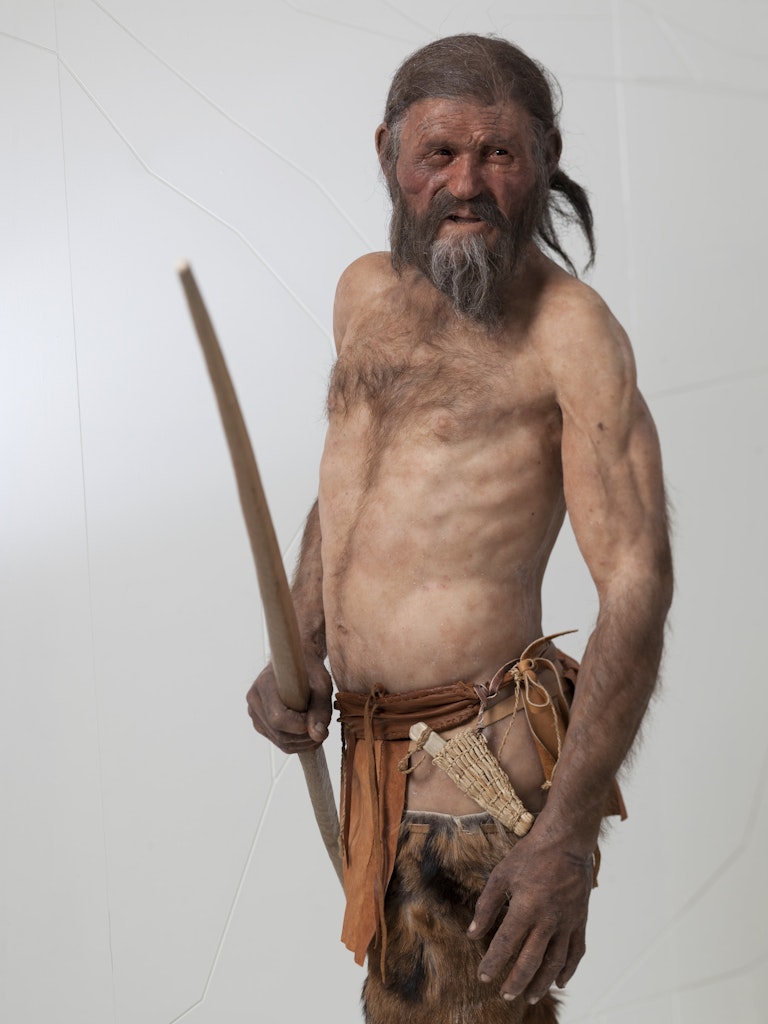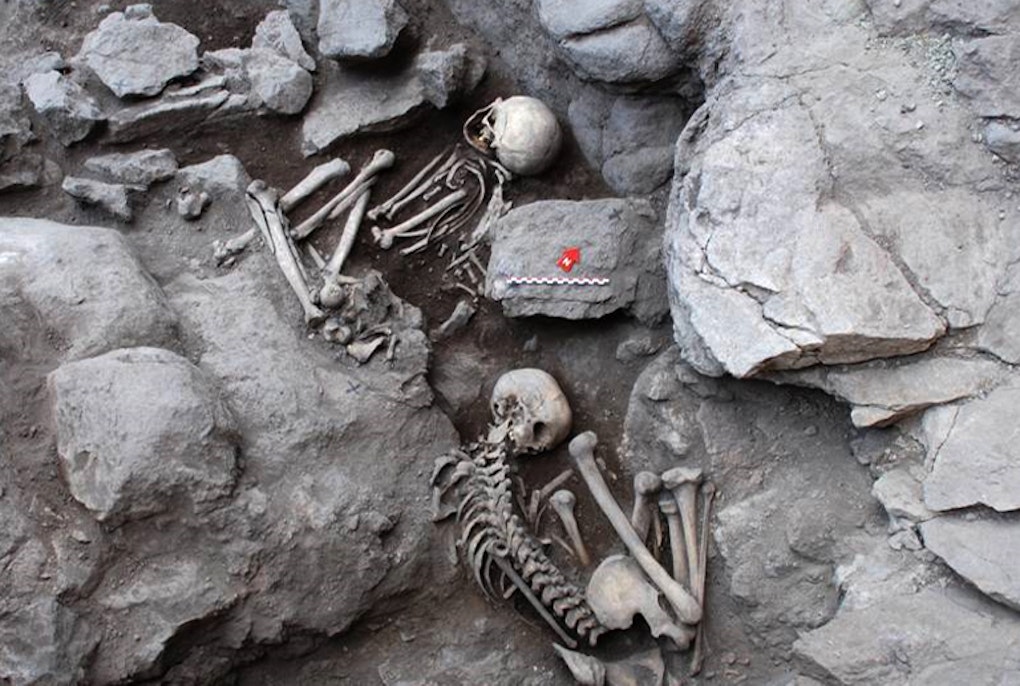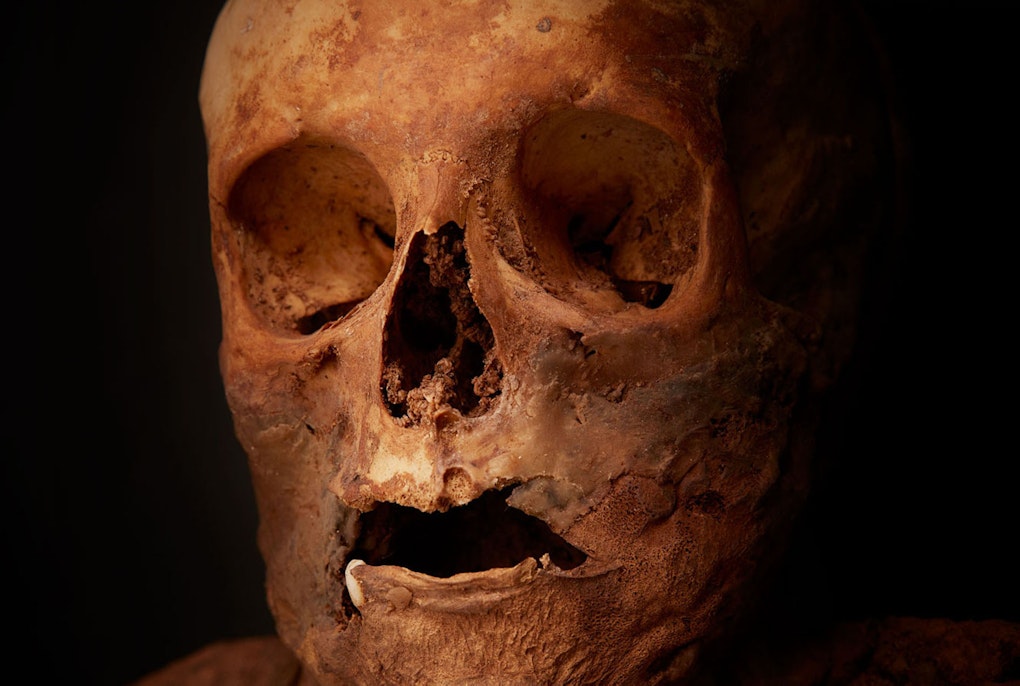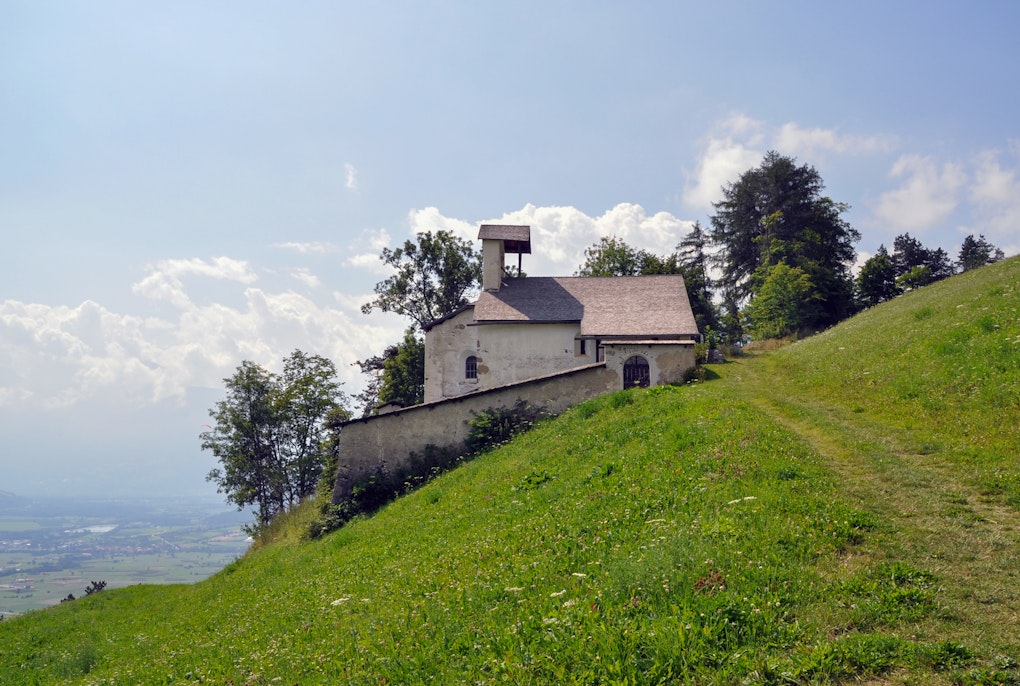magazine_ Interview
“The fact that Ötzi is 92 percent Anatolian may come as a surprise to many”
Interview with archaeogeneticist Johannes Krause and anthropologist Albert Zink
Ten years after the first analysis of Ötzi’s genome, improved sequencing technology has now enabled a research team from the Max Planck Institute for Evolutionary Anthropology and Eurac Research to reconstruct the Iceman’s genetic make up much more accurately. It shows that he had darker skin than previously thought, was most likely bald, and only eight percent of his genes are of European ancestry. Archaeogeneticist Johannes Krause and anthropologist Albert Zink explain the findings.
The Ötzi we know has hair down to his shoulders, your new results show, as a mature man, he most likely had advanced hair loss. How did you come up with the long hair in the first place?
Albert Zink: In reality, only a few individual hairs were originally found with Ötzi, and it was never investigated whether they really came from him, or which type of hairs they were - they could have been from his beard. Generally when corpses lie for such a long time in glaciers or water, their hair falls out because the uppermost epidermis is lost. This was why it was originally thought that there were no hairs on Ötzi, it was assumed they had fallen out and been washed away but, that they had been there to start with. From the beginning, the first reconstruction showed him with lots of hair on his head, it was the image people had of him. No one could imagine that he was bald or at least, had advanced hair loss.
We also have to correct our image of him in terms of his skin color. He had a darker skin tone than first thought, didn’t he?
Johannes Krause: I would say that you only have to look at the mummy. It likely represents Ötzi’s skin tone pretty well. It’s relatively dark skin, even darker than the darkest skin tones found in southern Europe today, such as Sicily or Andalusia; but not as dark as that of people with their origins south of the Sahara.
We analyzed Ötzi's genome in very high resolution and have obtained a precise, nuanced picture; the latest scientific findings have been incorporated into the study. After all, skin color is not determined by just one gene: There are hundreds of genetic loci that influence it.
Zink: It used to be thought that Ötzi’s skin got darker when he was mummified in the glacier, but actually this theory could not ever really be explained. Now we know that the Iceman’s skin color was in fact, as we see it now. Interestingly, many people who have visited the museum several times have the impression that the mummy has become darker over time. But it hasn’t: as part of the conservation strategy, the Ötzi’s skin has been constantly checked using standardized photographs to detect any changes. There haven’t been any.
Krause: Because of the reconstruction, we have a certain image of Ötzi in our heads. And the reconstruction is very light skinned. So, when one then sees the much darker mummy, one naturally might assume that the skin became darker later.
It used to be thought that Ötzi’s skin got darker when he was mummified in the glacier, but actually this theory could not ever really be explained. Now we know that the Iceman’s skin color was in fact, as we see it now.
Albert Zink
Will it take a while for the new image of Ötzi to catch on?
Zink: Definitely. But I think the current reconstruction in the South Tyrol Museum of Archaeology could be left as it is until a new one is made which takes our findings into account. That’s what happened before: Ötzi’s reconstruction used to have blue eyes; then we found out during the first genome study they were in fact brown, so the next model was adjusted.
Back when Ötzi lived, could it have been possible that all the people in the area had a similar skin tone?
Krause: Maybe. We studied a contemporaneous population in northern Italy, a little south of South Tyrol, where we found a similar genetic composition to Ötzi’s, so you can imagine that a darker skin tone was also common there. In general, early farmers had relatively dark skin but, not as dark as the hunter-gatherers who lived in Europe before them.
These hunter-gatherers would have had blue eyes and such dark skin that genetically speaking, we cannot distinguish them from people south of the Sahara today. This is a very unusual phenotype, quite different from the way we have until now imagined the original Europeans.
By the late Bronze Age, people in Europe were getting lighter very quickly. In fact, there is hardly a gene that has spread as fast as the genes for light skin color in Europe. We suspect this has to do with vitamin D and the change from hunting and gathering to farming. Early farmers took in very little vitamin D with their diet. However, humans can also produce the vitamin in their skin because of a precursor which reacts to penetrating UV light. Low pigmentation allows more UV light to penetrate. So, there was an advantage for light skin to survive in a Europe which was quite dark with little sunlight in winter, especially if you were a farmer. With Ötzi, this development had not yet been reflected, perhaps because he lived in southern Europe or because within his population there was still enough vitamin D from the diet at the time, through fish and meat for example.
We studied a contemporaneous population in northern Italy, a little south of South Tyrol, where we found a similar genetic composition to Ötzi’s, so you can imagine that a darker skin tone was also common there.
Johannes Krause
The question of what Ötzi looked like fascinates people, but the most important finding of your study concerns his ancestry: he had an unusually large number of genes in common with early Anatolian farmers. Please explain.
Krause: About 8.000 years ago, early farmers from Anatolia began to migrate into Europe, mixing with the hunter-gatherers who originally lived there. The hunter-gatherers merged with the early farmers, and at the end of this process, about 5,000 years ago, most of the early farmers in Europe carried between ten and fifty percent hunter-gatherer ancestry; some did have more, but most carried around ten percent. However, Ötzi, had just a little less than eight percent of his genetic ancestry from the European hunter-gatherers. None of his European contemporaries whose genomes we have available, and there are hundreds of them, share as much ancestry with early Anatolian farmers as Ötzi.
What can we conclude from this?
Krause: It suggests that he came from a relatively isolated population that had little contact with other European groups, and that not so many hunter-gatherers lived in this region. But to really make statements here, we need the genomes of more individuals. Only then will we see if Ötzi is representative of the population or if he’s an outlier. Albert and his team are working on this right now.
Zink: Yes, we have examined genetic material from numerous skeletal finds in South Tyrol and are currently evaluating the data. These skeletons are not all from the same period, and we have not reconstructed the genomes to the same degree as Ötzi’s, nevertheless the results will provide us with important clues as to whether Ötzi is an exception or representative of his region and time.
Another result on the ancestry corrects the first genome analysis. Namely, there are no traces of Eastern European steppe herders in Ötzi's genes.
Zink: These steppe herders are the third component in the ancestral gene mix of most of today’s Europeans. Immigration of steppe herders began about 4900 years ago, actually after Ötzi’s time. So it never quite fit that with Ötzi we found their genetic traces, but it could not be ruled out entirely that contact had not occured. However, now we know that these initial results were in fact caused by contamination with modern DNA.
Anatolian ancestors and dark skin. Can the new, more accurate image of Ötzi help to dispel the erroneous notion of a “pure” European population?
Zink: That would be highly desirable. After all, it is precisely studies such as these that show that our ancestors all immigrated at one time or another, that we are all a big genetic mixture. Unfortunately, this connection is often not made. But I think our results can improve our understanding of where Europeans actually come from.
Krause: I hope so, too. Ötzi, as the most famous early European human, is well suited to convey this important message. The fact that Ötzi is 92 percent Anatolian in his ancestry may come as a surprise to many. The same applies to the new findings on pigmentation: for many people, skin color is even more important than origin. There is this black-and-white thinking by some people that categorize humans by the color of their skin. It is therefore important to raise awareness of the fact that even in Europe, people have only recently become less pigmented and that subdividing human diversity by pigmentation makes no sense.
In Ötzi's genes, they also found a predisposition to type 2 diabetes and obesity - which may also come as a surprise to many who think that these are diseases of modern societies.
Zink: These results show that we cannot talk about “modern lifestyle diseases” as they have not developed as a result of our lifestyle alone, but rather because there is a predisposition to them that goes back a long way. I believe that this is also an important finding for modern medicine: a disease does not have to manifest itself even if such a predisposition is present. Ötzi probably didn't have diabetes, he wasn’t overweight, ate a very balanced diet and exercised a lot. But he did have atherosclerosis, which we will look at in more detail in another study. The Iceman’s heart exhibits calcification in the aorta, so he definitely had a risk of heart attack or stroke, even though he actually lived an extremely healthy life by today’s standards.
Krause: From an evolutionary point of view, this is not surprising. These risk genes exist in humans in Africa, Asia and Europe, and they were already present in the common ancestor of all these populations, 200,000 years ago - and likely also in Neanderthals.
Johannes Krause
Johannes Krause is director of the Max Planck Institute for Evolutionary Anthropology in Leipzig and author of the bestseller "A Short History of Humanity: How Migration Made Us Who We Are”.
Albert Zink
Albert Zink is an anthropologist and associate professor at the Ludwig-Maximilians-Universität in Munich. He has directed the Institute for Mummy Studies at Eurac Research since 2007.





